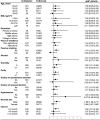Association between maternal pregestational glucose level and adverse pregnancy outcomes: a population-based retrospective cohort study
- PMID: 34493513
- PMCID: PMC8424840
- DOI: 10.1136/bmjopen-2020-048530
Association between maternal pregestational glucose level and adverse pregnancy outcomes: a population-based retrospective cohort study
Abstract
Objective: To investigate the association between maternal pregestational blood glucose level and adverse pregnancy outcomes.
Design: Retrospective cohort study.
Setting: This study was conducted in the Chongqing Municipality of China between April 2010 and December 2016.
Participants: A total of 60 222 women (60 360 pregnancies) from all 39 counties of Chongqing who participated in the National Free Preconception Health Examination Project and had pregnancy outcomes were included.
Primary outcome measures: Adverse pregnancy outcomes included spontaneous abortion, induced abortion or labour due to medical reasons, stillbirth, preterm birth (PTB), macrosomia, large for gestational age, low birth weight (LBW) and small for gestational age.
Results: Of the 60 360 pregnancies, rates of hypoglycaemic, normoglycaemia, impaired fasting glycaemia (IFG) and diabetic hyperglycaemic before conception were 5.06%, 89.30%, 4.59% and 1.05%, respectively. Compared with women with normoglycaemia, women with pregestational glucose at the diabetic level (≥7.0 mmol/L) might have a higher rate of macrosomia (6.18% vs 4.16%), whereas pregestational IFG seemed to be associated with reduced risks of many adverse outcomes, including spontaneous abortion, induced abortion due to medical reasons, PTB and LBW. After adjusting for potential confounders, pregestational diabetic hyperglycaemic was remained to be significantly associated with an increased risk of macrosomia (adjusted risk ratio 1.49, 95% CI 1.07 to 2.09). Abnormal maternal glucose levels before pregnancy (either hypoglycaemic or hyperglycaemic) seemed to have no significant negative effect on spontaneous abortion or induced abortion due to medical reasons.
Conclusion: Although without overt diabetes mellitus, women with once diabetic fasting glucose level during their preconception examinations could be associated with an increased risk for macrosomia. Uniform guidelines are needed for maternal blood glucose management during pre-pregnancy care to improve pregnancy outcomes.
Keywords: diabetes in pregnancy; epidemiology; public health; reproductive medicine.
© Author(s) (or their employer(s)) 2021. Re-use permitted under CC BY-NC. No commercial re-use. See rights and permissions. Published by BMJ.
Conflict of interest statement
Competing interests: None declared.
Figures



Similar articles
-
Preconception reproductive tract infections status and adverse pregnancy outcomes: a population-based retrospective cohort study.BMC Pregnancy Childbirth. 2022 Jun 20;22(1):501. doi: 10.1186/s12884-022-04836-3. BMC Pregnancy Childbirth. 2022. PMID: 35725418 Free PMC article.
-
Preconception diabetes mellitus and adverse pregnancy outcomes in over 6.4 million women: A population-based cohort study in China.PLoS Med. 2019 Oct 1;16(10):e1002926. doi: 10.1371/journal.pmed.1002926. eCollection 2019 Oct. PLoS Med. 2019. PMID: 31574092 Free PMC article.
-
The impact of maternal prepregnancy impaired fasting glucose on preterm birth and large for gestational age: a large population-based cohort study.Am J Obstet Gynecol. 2020 Mar;222(3):265.e1-265.e19. doi: 10.1016/j.ajog.2019.09.037. Epub 2019 Sep 28. Am J Obstet Gynecol. 2020. PMID: 31574291
-
Gestational Weight Gain and Adverse Maternal and Neonatal Outcomes for Pregnancies Complicated by Pregestational and Gestational Diabetes.Am J Perinatol. 2022 May;39(7):691-698. doi: 10.1055/s-0041-1739512. Epub 2021 Nov 28. Am J Perinatol. 2022. PMID: 34839478
-
Fetal biometry for guiding the medical management of women with gestational diabetes mellitus for improving maternal and perinatal health.Cochrane Database Syst Rev. 2019 Sep 3;9(9):CD012544. doi: 10.1002/14651858.CD012544.pub2. Cochrane Database Syst Rev. 2019. PMID: 31476798 Free PMC article.
Cited by
-
Pre-pregnancy intrauterine device use is associated with a reduced risk of subsequent preterm birth: a large population-based cohort study.BMC Public Health. 2025 Feb 18;25(1):670. doi: 10.1186/s12889-025-21766-9. BMC Public Health. 2025. PMID: 39966761 Free PMC article.
-
Maternal and foetal complications of pregestational and gestational diabetes: a descriptive, retrospective cohort study.Sci Rep. 2024 Apr 19;14(1):9017. doi: 10.1038/s41598-024-59465-x. Sci Rep. 2024. PMID: 38641705 Free PMC article.
-
A retrospective study on the impact of the timing of diabetes diagnosis on maternal and fetal outcomes.Arch Gynecol Obstet. 2025 May 30. doi: 10.1007/s00404-025-08047-x. Online ahead of print. Arch Gynecol Obstet. 2025. PMID: 40445207
-
Effects of magnesium sulfate combined with labetalol on vascular endothelial function and pregnancy outcomes in pregnant women with preeclampsia.Am J Transl Res. 2024 Nov 15;16(11):7096-7106. doi: 10.62347/COZZ1407. eCollection 2024. Am J Transl Res. 2024. PMID: 39678550 Free PMC article.
-
Association of Beverage Consumption during Pregnancy with Adverse Maternal and Offspring Outcomes.Nutrients. 2024 Jul 25;16(15):2412. doi: 10.3390/nu16152412. Nutrients. 2024. PMID: 39125293 Free PMC article.
References
Publication types
MeSH terms
Substances
LinkOut - more resources
Full Text Sources
Miscellaneous
